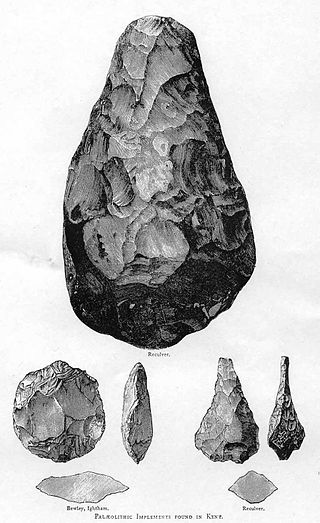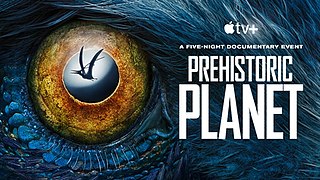| Peratosauroides | |
|---|---|
| Scientific classification | |
| Domain: | Eukaryota |
| Kingdom: | Animalia |
| Phylum: | Chordata |
| Class: | Amphibia |
| Family: | † Batrachosauroididae |
| Genus: | † Peratosauroides Naylor, 1981 |
Peratosauroides is an extinct genus of prehistoric salamander. [1]
| Peratosauroides | |
|---|---|
| Scientific classification | |
| Domain: | Eukaryota |
| Kingdom: | Animalia |
| Phylum: | Chordata |
| Class: | Amphibia |
| Family: | † Batrachosauroididae |
| Genus: | † Peratosauroides Naylor, 1981 |
Peratosauroides is an extinct genus of prehistoric salamander. [1]

In archaeological terminology, a projectile point is an object that was hafted to a weapon that was capable of being thrown or projected, such as a javelin, dart, or arrow. They are thus different from weapons presumed to have been kept in the hand, such as knives, spears, axes, hammers, and maces.

The Cave of Altamira is a cave complex, located near the historic town of Santillana del Mar in Cantabria, Spain. It is renowned for prehistoric cave art featuring charcoal drawings and polychrome paintings of contemporary local fauna and human hands. The earliest paintings were applied during the Upper Paleolithic, around 36,000 years ago. The site was discovered in 1868 by Modesto Cubillas and subsequently studied by Marcelino Sanz de Sautuola.

Prehistoric archaeology is a subfield of archaeology, which deals specifically with artefacts, civilisations and other materials from societies that existed before any form of writing system or historical record. Often the field focuses on ages such as the Stone Age, Bronze Age and Iron Age, although it also encompasses periods such as the Neolithic. The study of prehistoric archaeology reflects the cultural concerns of modern society by showing interpretations of time between economic growth and political stability. It is related to other disciplines such as geology, biology, anthropology, historiography and palaeontology, although there are noticeable differences between the subjects they all broadly study to understand; the past, either organic or inorganic or the lives of humans. Prehistoric archaeology is also sometimes termed as anthropological archaeology because of its indirect traces with complex patterns.

The caveman is a stock character representative of primitive humans in the Paleolithic. The popularization of the type dates to the early 20th century, when Neanderthals were influentially described as "simian" or "ape-like" by Marcellin Boule and Arthur Keith.

The Bhimbetka rock shelters are an archaeological site in central India that spans the Paleolithic and Mesolithic periods, as well as the historic period. It exhibits the earliest traces of human life in India and evidence of the Stone Age starting at the site in Acheulian times. It is located in the Raisen District in the Indian state of Madhya Pradesh, about 45 kilometres (28 mi) south-east of Bhopal. It is a UNESCO World Heritage Site that consists of seven hills and over 750 rock shelters distributed over 10 km (6.2 mi). At least some of the shelters were inhabited more than 100,000 years ago.

Les Eyzies-de-Tayac-Sireuil is a former commune in the Dordogne department in Nouvelle-Aquitaine in southwestern France. On 1 January 2019, it was merged into the new commune Les Eyzies.
Prehistoric fish are early fish that are known only from fossil records. They are the earliest known vertebrates, and include the first and extinct fish that lived through the Cambrian to the Quaternary. The study of prehistoric fish is called paleoichthyology. A few living forms, such as the coelacanth are also referred to as prehistoric fish, or even living fossils, due to their current rarity and similarity to extinct forms. Fish which have become recently extinct are not usually referred to as prehistoric fish. They were very different from what we have today. They likely were larger and had tougher scales.

Charles Robert Knight was an American wildlife and paleoartist best known for his detailed paintings of dinosaurs and other prehistoric animals. His works have been reproduced in many books and are currently on display at several major museums in the United States. One of his most famous works is a mural of Tyrannosaurus and Triceratops, which helped establish the two dinosaurs as "mortal enemies" in popular culture. Working at a time when many fossil discoveries were fragmentary and dinosaur anatomy was not well understood, many of his illustrations have later been shown to be incorrect representations. Nevertheless, he has been hailed as "one of the great popularizers of the prehistoric past".

The Megalithic Temples of Malta are several prehistoric temples, some of which are UNESCO World Heritage Sites, built during three distinct periods approximately between 3600 BC and 2500 BC on the island country of Malta. They had been claimed as the oldest free-standing structures on Earth until the discovery of Göbekli Tepe in Turkey. Archaeologists believe that these megalithic complexes are the result of local innovations in a process of cultural evolution. This led to the building of several temples of the Ġgantija phase, culminating in the large Tarxien temple complex, which remained in use until 2500 BC. After this date, the temple-building culture disappeared.

Prehistoric medicine is any use of medicine from before the invention of writing and the documented history of medicine. Because the timing of the invention of writing per culture and region, the term "prehistoric medicine" encompasses a wide range of time periods and dates.

Clairvaux-les-Lacs is a commune in the Jura department in Bourgogne-Franche-Comté in eastern France.

Doucier is a commune in the Jura department in Bourgogne-Franche-Comté in eastern France.

Fontenu is a commune in the Jura department in Bourgogne-Franche-Comté in eastern France.

Prehistory, also called pre-literary history, is the period of human history between the first known use of stone tools by hominins c. 3.3 million years ago and the beginning of recorded history with the invention of writing systems. The use of symbols, marks, and images appears very early among humans, but the earliest known writing systems appeared c. 5,200 years ago. It took thousands of years for writing systems to be widely adopted, with writing spreading to almost all cultures by the 19th century. The end of prehistory therefore came at different times in different places, and the term is less often used in discussing societies where prehistory ended relatively recently.

Prehistoric pile dwellings around the Alps are a series of prehistoric pile dwelling settlements in and around the Alps built from about 5000 to 500 BC on the edges of lakes, rivers or wetlands. In 2011, 111 sites located variously in Switzerland (56), Italy (19), Germany (18), France (11), Austria (5) and Slovenia (2) were added to the UNESCO World Heritage Site list. In Slovenia, these were the first World Heritage Sites to be listed for their cultural value.
Colorado Millennial Site is a prehistoric Paleo-Indian archaeological site located near Ruxton in the southeastern part of the U.S. state of Colorado, sitting along the border between Baca and Las Animas counties. It is also known by its site ID, 5LA1115, and the names Hackberry Springs and Bloody Springs.

The following outline is provided as an overview of and topical guide to prehistoric technology.

Batrachosauroididae is an extinct family of prehistoric salamanders with holarctic distribution. They were paedomorphic and presumably aquatic. They are possibly the sister taxon of Proteidae, an extant family of aquatic salamanders. They are definitively known from the Late Cretaceous to Miocene of North America and Europe. Remains from the earliest Cretaceous (Berriasian) Lulworth Formation of England have tenatively been attributed to this family.

Prehistoric Planet is a British–American nature documentary streaming television series about dinosaurs, that premiered on Apple TV+ beginning May 23, 2022. It is produced by the BBC Studios Natural History Unit, with Jon Favreau as showrunner, visual effects by MPC, and narration by natural historian Sir David Attenborough. The documentary follows dinosaurs and other prehistoric animals recreated with computer-generated imagery, living around the globe in the Late Cretaceous period 66 million years ago (Maastrichtian), just before the dinosaurs' extinction. It set out to depict prehistoric life using current palaeontological research by including accurately feathered dinosaurs, and speculative animal behaviour.